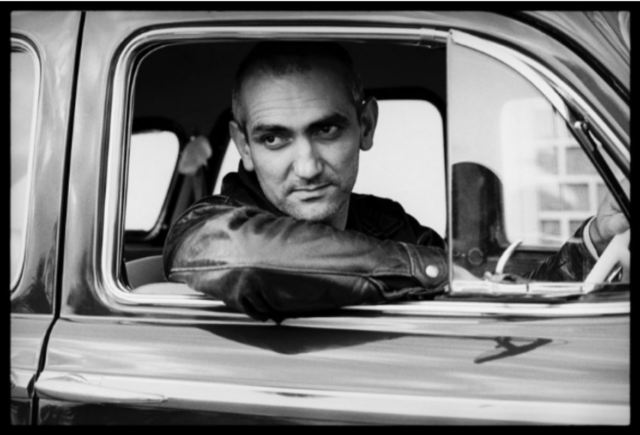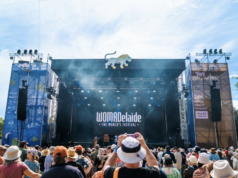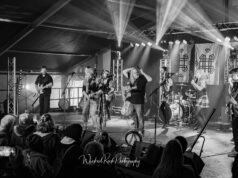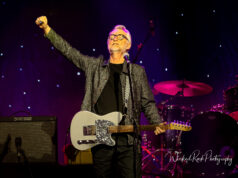Mark Moray – What came first, the camera or the music?
Wendy McDougall – The music. I first learned to play piano and recorder, then a bit of guitar, in primary school age. Photography was introduced to me in Year 11, and by the time Year 12 started I’d matched the two together and decided this was the path ahead.
MM – What was your first camera that you bought, and do you still have it?
WM – Olympus OM1N – It may be in a box somewhere but not seen but for ages.
MM – What was it like photographing bands in the 70’s and 80’s compared to now?
WM – More room. No passes required. No song limitations. You were one of a very few bunch of photographers taking photos, so your work was noticed a lot quicker too, which is probably why the band ‘The Angels’ asked to see what I was doing.
MM – What was the greatest challenge you faced with when you started out as a music photographer?
WM – Paying the rent.
MM – Using film in the early days, did you process your own photos?
WM – B/W = yes.
I worked in photo labs where I was working my way around at becoming a professional hand at colour printing. This gave me my skill for the b/w print at home, and the professional level it had to be.
MM – In Sydney and probably nationally there were the big three Aussie Rock’n Roll photographers known within the industry, Bob King, Philip Morris and Tony Mott. How difficult was it to be a female trying to make it in that style of profession?
WM – I didn’t focus on that. I remained focused on learning my skill and getting jobs. Tony, Bob and I lived in Sydney, and became good colleagues and friends. Tony in particular remains a very close friend to this day. We helped each other.
Gender for me didn’t come into it. It was the idea and skill that got you the next job, so I like to believe that anyway. Really, if you think about it, if I didn’t supply good photos and made the bands would look like rubbish, why would I get another job? Skill should always win.
MM – You have photographed some of Australia’s iconic musicians and bands when they were starting out in the music industry, The Angles, INXS, The Church just to name a few. Did you manage to build up any relationships with these musicians that made it easier for you to capture their image?
WM – Yes. In fact it was Doc Neeson from the ‘The Angels’ who first showed me trust and respect, and came along to a photo session on my invitation to try out some ideas. Some of these photos are in the exhibition. With his theatrical characteristics and imagination, Doc happily rolled with my ideas, and used these to inspire his own actions in front of the camera. The results of that first ‘off the stage’ session confirmed my life long interest in providing entertaining and conceptual’ images. I thought every band or front person would be like him, but they are not. Doc spoilt me in the best way.
When I connected with a band on a visual level, we would usually work a fair bit together. Much like where some bands would stick to their favourite Music Producer.
MM – Who did you photograph and thought “this band / musician is really going to make it big”.
WM – Diesel.
I first him as Johnny Diesel & The Injectors, a newly arrived band in Sydney. He then went on to a fantastic solo career and is still going strong.
MM – Which Australian act did you enjoy photographing the most?
WM – GANGgajang, The Dukes, Noiseworks, Jeff ‘Duffo’ Duff, INXS, Diesel, Nikka Costa, Matt Finish… there are so many though I did particularly have a soft spot for GANGgajang and any off shoot band those guys were in. It was a visual creative connection with them that remains strong today.
MM – What excited you the most, selling your first image, or seeing a photo you took make it on an album cover?
WM – Selling was exciting because it gave me the thumbs up to keep going but making an Album cover – that was the goal.
MM – Can you recall what those photos were?
WM – A live shot of ‘The Angels’ was first photo sold, and first cover was a Live EP by ‘The Angels’.
MM – You have also photographed some of the most recognised international artists such as Mick Jagger and Freddie Mercury. How did those opportunities arise?
WM – Smash Hits Magazine sent me along to the Freddie Mercury press conference. I probably hassled someone for a photo pass to Jagger, as the Rolling Stones are my favourite band and I had yet to see them live.
MM – The photo of Paul Kelly looking out from inside a car is such a wonderful image. (I really love this photo). How did this photo shoot come about?
WM – This was a publicity shoot. We were in Melbourne wandering around his favourite places and suburbs.
MM – Your exhibition ‘it’s only rock’n’roll but I like it…’ was exhibited in Sydney and is now coming to Melbourne. How long did it take you to choose the images you needed to exhibit and how many photos did you have to sort through to come up with the final ones?
WM – Some photos have stayed with me for years and years, either in my mind or folios that keep evolving.
Once I knew this show would be four months prior, I had to quickly try and fill the gaps so I guess I have to answer four months. There are still many uncovered images.
MM – in 2018 you were the winner of the Australian Women in Music Awards [AWMA] – Music Photographer category that recognizes a current photographer and body of work. How did this nomination come about, and how important is it to you to be recognised for your achievements?
WM – Two friends nominated me.
What I am enjoying from the responses and reactions of the exhibition is the way the general public who saw the bands, are reliving their memories, but mostly that every band and musician I have photographed, is receiving some recognition of their inclusion in our music industry. Everyone is a part of the industry, not just those who enjoyed success on top of the charts. It’s a collective, and I’m proud to be part of the industry where my images would go some way towards the acknowledgement of those musicians.
MM – Is there a person, musician or band that you haven’t photographed that sits as your number one ‘must photograph list’ assuming they are still around?
WM – I would have loved to photograph Kate Bush.
MM – You also have your hand in videos, food and other book publications, films, documentaries, and theatre. So what I would like to know is how do you have time for your Uke band ‘FOK ROK’? and who is the designated photographer for when you perform?
WM – Ha.. Music is the first love. Playing uke is now my social life, but after working with all those amazing talents it still feels surreal to be playing on the stage instead of watching.
I have created most of our press photos, and fortunately the lovely photographer Di Brooks happens to be a friend of one of our members, so she comes along to shoot the live images. We didn’t ask her to do this. It’s been a lovely organic process that she genuinely enjoys; it’s the best way to collaborate.
Canon Australia and SUNSTUDIOS are proud to present ‘It’s only rock ‘n’ roll but I like it…’ – an exhibition featuring the who’s who of Australian music from the past 40 years captured by award-winning photographer Wendy McDougall, “one of Australia’s best-known rock photographers” (Sydney Morning Herald, 2019). A selection of more than 140 images from McDougall’s extensive collection will be on show at SUNSTUDIOS from 9–24 May in Melbourne, after a headline-making hit run in Sydney. Images will be available for purchase at the gallery and a selection online.
EXHIBITION DETAILS
SUNSTUDIOS and Canon Experience Store complex South Melbourne
Dates: 9–24 May 2019
Hours: Mon–Sat 9:00am–5:30pm
Location: 95 Buckhurst Street South Melbourne
Admission is FREE.
AVAILABLE FOR PURCHASE
For selected image purchase and other details please visit: www.canon.com.au/wendymcdougall









